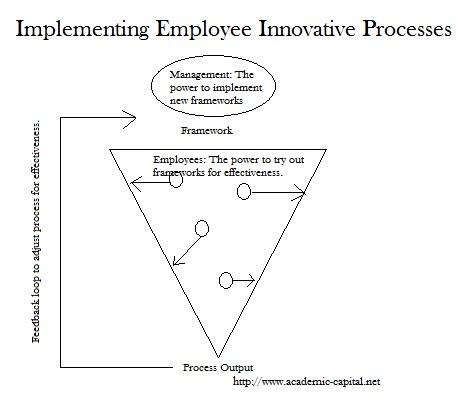Encouraging employees to be
agents in change is difficult due to the lack of theoretical frameworks
associated with the new innovative paradigm. To ask an employee who has not
contributed before to become a contributing member of organizational development
is difficult until they are able to formalize such concepts into a process and then
create an internalized routine of the new expectation. Developing employee
innovation requires the understanding of bounded rationality and the need to
create a methodology that fosters a participative process.
Employees follow a particular
pattern and routine throughout their working day (Nelson and Winter, 1982).
Even though these routines make for orderly workdays, ease of management, and
stability of the organization they do not necessarily improve upon the
organizations output. To encourage employees to act purposively, beyond daily
routine, requires the ability of employees to deliberatively plan and make
decisions (Kirzner, 1997).
Of course, one cannot expect employees
to suddenly become freethinking, mature, and participative employees without
changing the way they view their responsibilities to the organization and
themselves. In economics, organizations represent bounded rationality.
Employees are part of this bounded rationality and this has an impact on the
limited scope of their decision-making abilities and the possible outcomes based
within the organizational culture (Conlisk, 1996).
To change the poor employee
expectations bounded within an organizations culture requires changing and
adjusting the processes and routines by which employees operate. The ability to
help employees critically think and reflect on their experiences and work
practices requires social triggers through group interaction and social exchange
(Jensen and Meckling, 1976). In other
words, employee culture and social interaction with management should change to create higher
expectations of performance.
The bounded rationality of
organizations must become unbounded and rebounded on new principles and
perceptions. Problem solving and innovative employees will require a new way of
viewing themselves, their responsibilities, and their potential contributions
to the organization. Instead of seeing themselves as process following,
unquestioning, and uninspired contributors, they should be encouraged to
question and contribute to organizational objectives through strong
management-employee relationships that foster collaboration in problem solving.
One of the greatest social
exchanges in innovation is between management and employee; management having
the ability to use resources to implement ideas and the employees having the
ability to find solutions to problems in their daily routines. Managers should
create the right atmosphere and positive regard for employee ideas even if such
ideas are not practical in the short-term. Employees invest a considerable
amount of face and self-image when they bring forward ideas that may be blindly
ignored by management despite the merit or benefit of those ideas (Clegg et al,
2002).
A single negative interaction
with a manager will lessen the likelihood of that employee bringing forward
those ideas again. Repeated among multiple employees and a culture begins to
form with an ever-expanding divide between employees and management. To rectify
this situation it may be beneficial for managers to write down ideas, no matter
how silly they may seem at the time, and create a running battery of employee
ideas for possible future development. A single idea may become a goldmine of
resources in the future.
Innovation is not a process of
certainty that has specific outcomes from the start. In innovation, ideas
develop, transform into practical ideas, and are eventually created for the
market. Because innovation is not able to be calculated numerically (Lewis,
2008) the collection of ideas today it can still help formulate future
solutions to problems through the hedging of the large group of employees
participating in daily organizational functioning. Management must only open up
the possibility to the perspective that employees are not as incompetent as
they seem.
Providing a useful framework
where employees may participate based upon their abilities can be beneficial
for developing employee innovative contribution. Management may have the power
to implement ideas but employees know if such ideas should be adjusted or
disregarded in order to make them more effective. The two responsibilities can
be provided into a framework for higher levels of employee-management collaboration.
According to Kesting and Ulhoi (2010) it is possible
to create employee driven innovation processes through the following
methodology:
-There are managers and employees and each has their
own authority level.
-Management innovation decisions are imperfect and
only provide a framework.
-Employees must fill out this frame with operative
and supportive decisions.
-Through trying this frame employees must go back to
management to provide feedback.
-In time employee internalize routines and work off
of autopilot until change is needed again.
In this methodology, management
provides a framework through their authority and employees try the framework
providing constant feedback on its effective utility. When adjustments are
necessary, based upon this feedback, management changes the structure to
improve the process. Overtime the new processes become routine and work off of
processes of internalized expectation until change is needed again. In the
process provided by Kesting & Ulhoi employee innovation is a supportive
feedback loop to the effectiveness of management decisions. This requires the
ability of management to be receptive to this feedback and implement change
when necessary.
Clegg, C., Unsworth, K.,
Epitropaki, O.& Parker, G. (2002), Implicating trust in the innovation
process. Journal of Occupational and Organizational Psychology, 75 (4), pp. 409-22.
Conlisk, J. (1996). Why bounded
rationality? Journal of Economic
Literature, 34, pp. 669-700.
Jensen, M.& Meckling, W.
(1976), Theory of the firm: managerial behavior, agency costs, and ownership
structure”, Journal of Financial Economics,
3, pp. 305-60.
Kesting, P. & Ulhoi, J. (2010). Employee-driven innovation: extending
the license to foster innovation. Management Decision,
Kirzner, I. (1997). Entrepreneurial
discovery and the competitive market process: an Austrian approach, Journal of Economic Literature, 35, pp.
60-85.
Lewis, P. (2008), Uncertainty,
power and trust. Journal of Austrian
Economics, 21. pp. 103-98.
Nelson, R. and Winter, S. (1982).
An Evolutionary Theory of Economic Change. Harvard University Press, Cambridge,
MA.

No comments:
Post a Comment